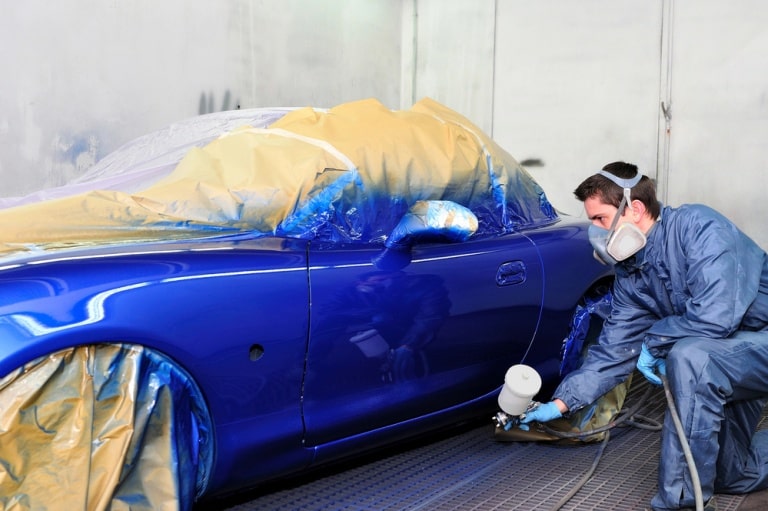Spray painting is a handy method to coat large projects in a relatively short amount of time. But after completing the process, you might wonder how long you should wait before it dries up, and that’s where this guide comes in handy!
Keep reading to learn more about the ideal wait times for spray painting, including the different factors that impact it and essential tips to keep in mind during the process!
How Long Should You Wait After Spray Painting?
The exact time spray paint needs to fully dry and cure can vary significantly depending on various factors.
But as a general rule, you should expect it to take between a few minutes to several hours.
If you’re unsure about the type of spray paint you’re using, it’s usually best to wait at least 8 hours before spraying the surface with a new coat or proceeding to the finishing step.
Factors Affecting Spray Paint Drying Times
The following factors can significantly impact your spray paint drying time, so they can help you narrow down your expected drying time significantly.
Type of Paint Used
The most critical factor to consider while spray painting is the type of paint you’re using, as the difference between the drying time of aerosol solutions can vary widely. Here’s a quick look at the expected drying time of each type:
- Acrylic: 1 to 2 Hours; fully cures in 12 to 24 hours (The most common type of paint)
- Epoxy: 30 to 60 Minutes, fully cures in 6 to 8 hours
- Fast-drying: 5 to 10 minutes
- Enamel: 2 to 3 hours, fully cures in 24 hours.
- Lacquer: 2 to 4 hours, fully cures in 24 to 48 hours.
- Oil-based: 6 to 8 hours, fully cures in 48 to 72 hours
- Latex: 6 to 8 hours, fully cures in 36 to 72 hours
Environmental Conditions
Besides the type of paint, the surrounding conditions also have an impact on the speed of drying.
As a general rule, environmental conditions are why the previously mentioned paint types dry within a varying range of time.
Ideally, warmer temperatures speed up the drying process, but a temperature too hot will result in uneven drying (inside and out), resulting in cracking later on. To avoid that, keep the temperature between 40 to 80 degrees.
This also applies to humidity, as paint will naturally cure faster in dry air with a humidity range between 40% and 50%. Avoid going lower than 30% because it can also result in cracking.
Lastly, airflow is another crucial factor that can massively improve drying time. That’s why drying up outdoors or setting up a fan near the painted item (but not directly pointed at it) is generally a good idea.
Surface Texture
The nature of the surface you’re coating can also affect the paint’s drying time, although not as critically as the previous factors.
For instance, applying paint directly to wood or concrete means you should expect slower drying times, as they’re highly porous, so they absorb more paint.
On the other hand, smooth, non-porous materials usually dry up faster when painted because the paint stays on top and is exposed to air, so it evaporates faster.
Coat Thickness
Thicker paint coats may end up drying simultaneously at a surface level. However, it makes a world of difference in terms of fully curing.
This is because the internal layer of solvent takes much longer to evaporate than the external one.
Helpful Tips While Spray Painting and Drying
Here are some reliable tips to remember while spray painting for a smooth experience.
Adjust Your Conditions for the Optimal Drying Time
To speed up the drying process while getting the best results, spray paint in a well-ventilated room at 80 degrees Fahrenheit and 40% humidity. You may also opt for a different paint type for a better drying rate.
Several Thinner Coats Is Better Than One Thick Coat
It’s always best to apply a fresh coat on a fully cured piece rather than being just dry at the surface.
To achieve that, keep your coats as thin as possible and apply more to reach the coating level you prefer.
Check the Label
While the previously mentioned drying times are generalized, every brand has its formula that may dry faster or slower. Luckily, most of them will mention a more approximate drying time on the label, so use them for guidance.
Opt for Safety While Spray Painting
Always wear safety gear like gloves, respirators, and eye protection during spray painting to avoid irritation.
FAQs
Is curing and drying the same thing?
Curing and drying are different stages in the painting process. Drying is when paint feels dry to the touch when the solvent evaporates.
On the other hand, curing is when the paint reaches its full strength and durability as it fully hardens.
Can I speed up the drying time with a hairdryer or a heat gun?
You should avoid using hairdryers or heat guns to speed up drying. Since they focus on one spot, they can cause uneven drying, cracking, or bubbling in the paint.
If speed is crucial, consider using a different spray paint specifically designed for quicker drying times, but be aware of the potential durability trade-off.








